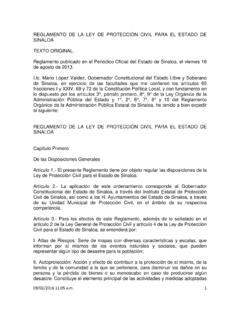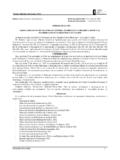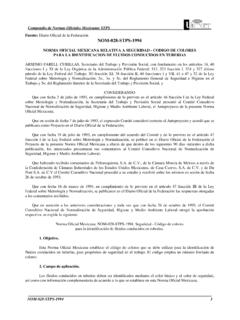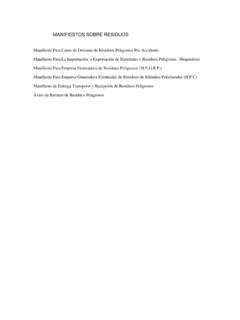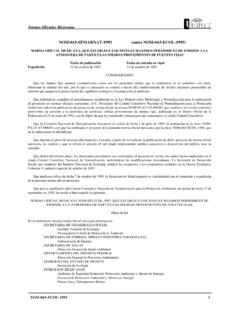Transcription of METHOD 8081 ORGANOCHLORINE PESTICIDES AND PCBs …
1 CD-ROM8081 - 1 Revision 0 September 1994 METHOD 8081 ORGANOCHLORINE PESTICIDES AND PCBs AS AROCLORS BY GASCHROMATOGRAPHY: CAPILLARY COLUMN AND 8081 is used to determine the concentrations of variousorganochlorine PESTICIDES and polychlorinated biphenyls (PCBs) as Aroclors, inextracts from solid and liquid matrices. Open-tubular, capillary columns wereemployed with electron capture detectors (ECD) or electrolytic conductivitydetectors (ELCD). When compared to the packed columns, these fused-silica, open-tubular columns offer improved resolution, better selectivity, increasedsensitivity, and faster analysis. The list below is annotated to show whether asingle- or dual-column analysis system was used to identify each target analyte. Compound NameCAS Registry No. Aldrin 309-00-2a,bAroclor-101612674-11-2a,bAroc lor-1221 1104-28-2a,bAroclor-123211141-16-5a,bAro clor-124253469-21-9a,bAroclor-124812672- 29-6a,bAroclor-125411097-69-1a,bAroclor- 126011096-82-5a,b-BHC 319-84-6a,b-BHC 319-85-7a,b-BHC (Lindane) 58-89-9a,b-BHC 319-86-8a,bChlorobenzilate 510-15-6b-Chlordane 5103-71-9b-Chlordane 5103-74-2a,bDBCP 96-12-8b4,4'-DDD 72-54-8a,b4,4'-DDE 72-55-9a,b4,4'-DDT 50-29-3a,bDiallate 2303-16-4bDieldrin 60-57-1a,bEndosulfan I 959-98-8a,bEndosulfan II33213-65-9a,bEndosulfan sulfate 1031-07-8a,bEndrin 72-20-8a,bEndrin aldehyde 7421-93-4a,bEndrin ketone53494-70-5b CD-ROM8081 - 2 Revision 0 September 1994 Compound NameCAS Registry No.
2 Heptachlor 76-44-8a,bHeptachlor epoxide 1024-57-3a,bHexachlorobenzene 118-74-1bHexachlorocyclopentadiene 77-47-4bIsodrin 465-73-6bKepone 143-50-0bMethoxychlor 72-43-5a,bToxaphene 8001-35-2a,b Single-column analysis a Dual-column analysisb analyst must select columns, detectors and calibration proceduresmost appropriate for the specific analytes of interest in a study. Matrix-specific performance data must be established and the stability of the analyticalsystem and instrument calibration must be established for each analytical matrix( , hexane solutions from sample extractions, diluted oil samples, etc.). performance data are presented for many of the listedchemicals, it is unlikely that all of them could be determined in a singleanalysis.
3 This limitation results because the chemical and chromatographicbehavior of many of these chemicals can result in co-elution. Severalcleanup/fractionation schemes are provided in this METHOD and in METHOD chemical is a potential METHOD interference when it is not a target multi-component mixtures ( , Aroclors and Toxaphene) arelisted as target compounds. When samples contain more than one multi-componentanalyte, a higher level of analyst expertise is required to attain acceptablelevels of qualitative and quantitative analysis. The same is true of multi-component analytes that have been subjected to environmental degradation ordegradation by treatment technologies. These result in "weathered" Aroclors (orany other multi-component mixtures) that may have significant differences in peakpatterns than those of standards. In these cases, individual congener analysesmay be preferred over total mixture identification based on single column analysis should beconfirmed on a second column, or should be supported by at least one otherqualitative technique.
4 This METHOD describes analytical conditions for a secondgas chromatographic column that can be used to confirm the measurements made withthe primary column. GC/MS METHOD 8270 is also recommended as a confirmationtechnique if sensitivity permits (Sec. 8). METHOD describes a dual column option. The option allows ahardware configuration of two analytical columns joined to a single injectionport. The option allows one injection to be used for dual column - 3 Revision 0 September 1994 Analysts are cautioned that the dual column option may not be appropriate whenthe instrument is subject to mechanical stress, many samples are to be run in ashort period, or when contaminated samples are METHOD is restricted to use by or under the supervision ofanalysts experienced in the use of a gas chromatograph (GC) and in theinterpretation of gas chromatograms. Each analyst must demonstrate the abilityto generate acceptable results with this suitable for analysis by this METHOD may also be analyzedfor organophosphorus PESTICIDES ( METHOD 8141).
5 Some extracts may also besuitable for triazine herbicide analysis, if low recoveries (normally samplestaken for triazine analysis must be preserved) are not a following compounds may also be determined using this METHOD : Compound NameCAS Registry No. Alachlor15972-60-8a,bCaptafol 2425-06-1bCaptan 133-06-2bChloroneb 2675-77-6bChloropropylate99516-95-7bChlo rothalonil 1897-45-6bDCPA 1861-32-1bDichlone 117-80-6bDicofol 115-32-2bEtridiazole 2593-15-9bHalowax-100058718-66-4bHalowax -100158718-67-5bHalowax-101312616-35-2bH alowax-101412616-36-3bHalowax-1051 2234-13-1bHalowax-109939450-05-0bMirex 2385-85-5bNitrofen 1836-75-5bPCNB 82-68-8bPerthane 72-56-0bPropachlor1918-16-17bStrobane 8001-50-1btrans-Nonachlor39765-80-5btran s-Permethrin51877-74-8bTrifluralin 1582-09-8b Single-column analysis a Dual-column analysisb CD-ROM8081 - 4 Revision 0 September OF measured volume or weight of sample (approximately 1 L for liquids,2 g to 30 g for solids)
6 Is extracted using the appropriate sample extractiontechnique. Liquid samples are extracted at neutral pH with methylene chlorideusing either a separatory funnel ( METHOD 3510) or a continuous liquid-liquidextractor ( METHOD 3520). Solid samples are extracted with hexane-acetone (1:1)or methylene chloride-acetone (1:1) using either Soxhlet extraction (Method3540), Automated Soxhlet ( METHOD 3541), or Ultrasonic Extraction ( METHOD 3550).A variety of cleanup steps may be applied to the extract, depending on (1) thenature of the coextracted matrix interferences and (2) the target cleanup, the extract is analyzed by injecting a 1- L sample into a gaschromatograph with a narrow- or wide-bore fused silica capillary column andelectron capture detector (GC/ECD) or an electrolytic conductivity detector(GC/ELCD). to methods 3500 (Sec. 3, in particular), 3600, and of interference in this METHOD can be grouped into threebroad categories: contaminated solvents, reagents or sample processing hardware;contaminated GC carrier gas, parts, column surfaces or detector surfaces; and thepresence of coeluting compounds in the sample matrix to which the ECD willrespond.
7 Interferences coextracted from the samples will vary considerably fromwaste to waste. While general cleanup techniques are referenced or provided aspart of this METHOD , unique samples may require additional cleanup approaches toachieve desired degrees of discrimination and by phthalate esters introduced during samplepreparation can pose a major problem in pesticide determinations. Thesematerials may be removed prior to analysis using Gel Permeation Cleanup -pesticide option ( METHOD 3640) or as Fraction III of the silica gel cleanupprocedure ( METHOD 3630). Common flexible plastics contain varying amounts ofphthalate esters which are easily extracted or leached from such materials duringlaboratory operations. Cross-contamination of clean glassware routinely occurswhen plastics are handled during extraction steps, especially when solvent-wettedsurfaces are handled. Interferences from phthalate esters can best be minimizedby avoiding contact with any plastic materials and checking all solvents andreagents for phthalate contamination.
8 Exhaustive cleanup of solvents, reagentsand glassware may be required to eliminate background phthalate must be scrupulously cleaned. Clean all glassware as soonas possible after use by rinsing with the last solvent used. This should befollowed by detergent washing with hot water, and rinses with tap water andorganic-free reagent water. Drain the glassware and dry in an oven at 130C foroseveral hours or rinse with methanol and drain. Store dry glassware in a presence of elemental sulfur will result in broad peaks thatinterfere with the detection of early-eluting ORGANOCHLORINE PESTICIDES . SulfurCD-ROM8081 - 5 Revision 0 September 1994contamination should be expected with sediment samples. METHOD 3660 is suggestedfor removal of sulfur. Since the recovery of Endrin aldehyde (using the TBAprocedure) is drastically reduced, this compound must be determined prior tosulfur , lipids, and other high molecular weight co-extractables canbe removed by Gel-Permeation Cleanup ( METHOD 3640).
9 May be difficult to quantitate Aroclor patterns and singlecomponent PESTICIDES together. Some PESTICIDES can be removed by sulfuricacid/permanganate cleanup ( METHOD 3665) and silica fractionation ( METHOD 3630).Guidance on the identification of PCBs is given in Sec. following target analytes coelute using single column analysis:DB 608 Trifluralin/Diallate isomersPCNP/Dichlone/IsodrinDDD/Endosulf an IIDB 1701 Captan/ChlorobenzilateCaptafol/MirexDDD/ Endosulfan IIMethoxychlor/Endosulfan halogenated PESTICIDES or industrial chemicals mayinterfere with the analysis of PESTICIDES . Certain co-elutingorganophosphorus PESTICIDES are eliminated by the Gel PermeationChromatography cleanup - pesticide option ( METHOD 3640). Co-elutingchlorophenols are eliminated by Silica gel ( METHOD 3630), Florisil (Method3620), or Alumina ( METHOD 3610) following compounds coelute using the dual column analysis. Twotemperature programs are provided for the same pair of columns as option 1 andoption 2 for dual column analysis.
10 In general, the DB-5 column resolves fewercompounds that the DB-1701 , thin film, slow ramp: See Sec. 7 and Table epoxideEndosulfan I/-ChlordanePerthane/EndrinEndosulfan II/Chloropropylate/Chlorobenzilate4,4'-D DT/Endosulfan sulfateMethoxychlor/DicofolPerthane/Endr in and Chlorobenzilate/Endosulfan II/Chloropropylatewill also co-elute on DB-5 after moderate deterioration in - 6 Revision 0 September 1994DB-1701 Chlorothalonil/-BHC-BHC/DCPA/trans-Perme thrin-Chlordane/trans-NonachlorCaptan/Di eldrinChlorobenzilate/ChloropropylateChl orothalonil/-BHC and -Chlordane/trans-Nonachlor will co-eluteon the DB-1701 column after moderate deterioration in column , Dichlone, Carbophenothion, Dichloran and Kepone wereremoved from the composite mixture because of extensive peak tailing onboth columns. Simazine and Atrazine give poor responses on the ECDdetector. Triazine compounds should be analyzed using METHOD 8141 (NPDoption). , thick film, fast ramp: See Sec.
